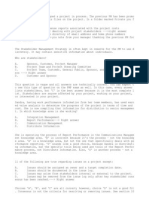AKASH CHOWDHURY - Software
AKASH CHOWDHURY - Software
Uploaded by
priyanka.debnath.cse.2021Copyright:
Available Formats
AKASH CHOWDHURY - Software
AKASH CHOWDHURY - Software
Uploaded by
priyanka.debnath.cse.2021Original Title
Copyright
Available Formats
Share this document
Did you find this document useful?
Is this content inappropriate?
Copyright:
Available Formats
AKASH CHOWDHURY - Software
AKASH CHOWDHURY - Software
Uploaded by
priyanka.debnath.cse.2021Copyright:
Available Formats
RISK ESTIMATION TECHNIQUES
AKASH CHOWDHURY
ROLL NUMBER: 18700121018
REGISTRATION NUMBER : 211870100110046
DEPARTMENT : COMPUTER SCIENCE ENGINEERING
YEAR : 3RD
BATCH : 2021 - 2025
1. ABSTRACT
Risk estimation is a critical aspect of software engineering that plays a pivotal role in the
success of software projects. This technical report provides an overview of various risk
estimation techniques used in software engineering. It discusses the importance of risk
estimation, common challenges, and presents a comprehensive analysis of popular methods,
including qualitative and quantitative approaches. Additionally, it explores emerging trends
and best practices in risk estimation.
2. INTRODUCTION
Software development is inherently risky, with numerous factors that can lead to project
failure, such as budget overruns, schedule delays, and quality issues. Risk estimation aims to
identify and assess potential risks so that appropriate mitigation strategies can be devised.
This report discusses the techniques and methods employed in the field of software
engineering for estimating and managing risks effectively.
3. IMPORTANCE OF RISK ESTIMATION
3.1. Project Success: Accurate risk estimation contributes to project success by
identifying potential problems early in the development cycle, allowing for timely
corrective actions.
3.2. Resource Allocation: It helps in the efficient allocation of resources by
prioritizing high-impact risks, thereby preventing costly surprises later in the
project.
3.1. Stakeholder Communication: Effective risk estimation aids in transparent
communication with stakeholders, setting realistic expectations, and building
trust.
4. CHALLENGES IN RISK ESTIMATION
4.1.Uncertainty: Software projects are inherently uncertain due to changing
requirements, technology, and market conditions.
4.2.Subjectivity: Estimating risks often relies on expert judgment, making it
subjective and prone to biases.
4.3.Data Availability: Historical data on similar projects may not always be available,
making estimation challenging.
5. QUALITATIVE RISK ESTIMATION TECHNIQUES
5.1.Expert Opinion
5.1.1. Description: Experts in the field assess and rank risks based on their
judgment and experience.
5.1.2. Pros: Quick, useful for early-stage estimation.
5.1.3. Cons: Subjective, relies on expert availability.
5.2.Delphi Method
5.2.1. Description: A structured communication process among experts to
reach a consensus on risk assessments.
5.2.2. Pros: Reduces individual biases, provides a collective expert opinion.
5.2.3. Cons: Time-consuming, may require multiple iterations.
6. QUANTITATIVE RISK ESTIMATION TECHNIQUES
6.1.Monte Carlo Simulation
6.1.1. Description: A statistical technique that models project variables and
iterates through thousands of simulations to estimate risk exposure.
6.1.2. Pros: Provides probabilistic risk assessment, handles complex
interdependencies.
6.1.3. Cons: Requires extensive data and computational resources.
6.2.Analytical Hierarchy Process (AHP)
6.2.1. Description: A structured method for pairwise comparisons of risks to
derive a prioritized risk ranking.
6.2.2. Pros: Provides a systematic way to compare and prioritize risks.
6.2.3. Cons: Subject to inconsistency in expert judgments.
7. EMERGING TRENDS AND BEST PRACTICES
7.1. Machine Learning: The integration of machine learning algorithms for risk
prediction based on historical project data.
7.2. Agile Risk Management: Continuous risk assessment and mitigation integrated
into agile development processes.
7.3. Crowdsourced Risk Assessment: Leveraging the wisdom of crowds for risk
estimation through online platforms.
8. CONCLUSION
Effective risk estimation is crucial for the success of software engineering projects.
Qualitative and quantitative techniques, along with emerging trends, offer various approaches
to tackle this challenge. By understanding the importance of risk estimation, acknowledging
its inherent challenges, and adopting best practices, software development teams can enhance
their ability to deliver successful projects while managing and mitigating potential risks.
9. REFERENCES
9.1.Boehm, B. W. (1989). Software Risk Management: Principles and Practices. IEEE
Software, 1(1), 32-41.
9.2.Hillson, D., & Murray-Webster, R. (2007). Understanding and Managing Risk
Attitude. Gower Publishing, Ltd.
9.3.Project Management Institute. (2017). A Guide to the Project Management Body
of Knowledge (PMBOK® Guide) (6th ed.). Project Management Institute, Inc.
9.4.Schmidt, C., & Lyytinen, K. (2002). Seven Guiding Threads for Conducting
Action-Oriented Research in Software Engineering. Information and Software
Technology, 44(13), 797-806.
You might also like
- PGMT Individual Assignment 2Document1 pagePGMT Individual Assignment 2Saurabh Puthran0% (1)
- Project Management at Deep Blue SeawaysDocument5 pagesProject Management at Deep Blue SeawaysDreNo ratings yet
- RISQS Core Sentinel CDM Compliance MatrixDocument36 pagesRISQS Core Sentinel CDM Compliance MatrixSaurabh GuptaNo ratings yet
- L4 Diploma in Health and Social Care Management AssignmentsDocument29 pagesL4 Diploma in Health and Social Care Management Assignmentsaahiloman1230% (1)
- Survey Work HSE Risk AssessmentsDocument2 pagesSurvey Work HSE Risk AssessmentsSarfraz Randhawa100% (1)
- Project Management - Midterm Review Mgt4460Document9 pagesProject Management - Midterm Review Mgt4460doannamphuocNo ratings yet
- Project Management Report On Bike Assembly PlantDocument16 pagesProject Management Report On Bike Assembly PlantSwagat MohantyNo ratings yet
- Case Study PMDocument9 pagesCase Study PMAnuradha DissanayakeNo ratings yet
- Unit 4 IpDocument7 pagesUnit 4 IpJohannah MunozNo ratings yet
- Lahore School of Economics Financial Management II Cash Flow Estimation and Risk Analysis - 2Document2 pagesLahore School of Economics Financial Management II Cash Flow Estimation and Risk Analysis - 2IIBRAHIM 245No ratings yet
- Paper Tower Project - Report (Group-4)Document23 pagesPaper Tower Project - Report (Group-4)bilalahmedshNo ratings yet
- Data Analytics: The Key To Risk-Based AuditingDocument11 pagesData Analytics: The Key To Risk-Based AuditingRafik BelkahlaNo ratings yet
- Kanu Project NewDocument33 pagesKanu Project NewmaingeekayNo ratings yet
- PROJECT CHARTER For Portal MigrationsDocument5 pagesPROJECT CHARTER For Portal MigrationsPabba SanathNo ratings yet
- Mini - Project BtbsDocument17 pagesMini - Project Btbssuhas kolliparaNo ratings yet
- Cab Service WBS Amp RR PDFDocument10 pagesCab Service WBS Amp RR PDFKashif ManzoorNo ratings yet
- Leadership PmbokDocument6 pagesLeadership PmbokBharath ChandraNo ratings yet
- Nishat Linen (Apparel) G5Document23 pagesNishat Linen (Apparel) G5fariya baigNo ratings yet
- Report Hamza ShafiDocument52 pagesReport Hamza Shafilaibalaiba12idNo ratings yet
- Pom SCMDocument24 pagesPom SCMaoishic2025No ratings yet
- Proposal For Setting Up PMO in Alpha-Net Telecommunication CompanyDocument19 pagesProposal For Setting Up PMO in Alpha-Net Telecommunication CompanyMuazam AliNo ratings yet
- Past Simple and Past ContinuousDocument2 pagesPast Simple and Past ContinuousAnalaura NúñezNo ratings yet
- Pakistan ExportDocument10 pagesPakistan ExportAhmad SiddiqueNo ratings yet
- Assignment CASE STUDY - PPCDocument1 pageAssignment CASE STUDY - PPCRahul Chhabra0% (1)
- Exploration of Software Engineering Lifecycle and Software Design of A Case Study CMP7243 Software Analysis and Design Student ID: Submission DateDocument16 pagesExploration of Software Engineering Lifecycle and Software Design of A Case Study CMP7243 Software Analysis and Design Student ID: Submission Datel145878No ratings yet
- Motivational Theory Case Study - Rolan MamaliasDocument4 pagesMotivational Theory Case Study - Rolan MamaliasMark Louie Aguilar100% (1)
- Six Sigma Mba ProjectDocument40 pagesSix Sigma Mba ProjectSagar KhursangeNo ratings yet
- A Work Breakdown Structure For Implementing and Costing An ERP Project 96Document8 pagesA Work Breakdown Structure For Implementing and Costing An ERP Project 96sholaNo ratings yet
- Global Trade in Home TextilesDocument14 pagesGlobal Trade in Home Textilessrahman24No ratings yet
- Capm QuestionsDocument6 pagesCapm QuestionsyenNo ratings yet
- All AssignmentsDocument38 pagesAll Assignmentsalanoudja18No ratings yet
- On Project FinanceDocument80 pagesOn Project Financenithinjohnjacob100% (1)
- Resume AfreenDocument3 pagesResume AfreenAfreen YunusNo ratings yet
- The Role of IT in Project ManagementDocument21 pagesThe Role of IT in Project Managementayushjain.proNo ratings yet
- Project Management Theory and Practice (MBA 7023) Individual AssignmentDocument30 pagesProject Management Theory and Practice (MBA 7023) Individual Assignmentjey456No ratings yet
- Literature ReviewDocument9 pagesLiterature ReviewSugandha KumariNo ratings yet
- Internship Report On Supply Chain Management Process in The Textile Division of Union LimitedDocument52 pagesInternship Report On Supply Chain Management Process in The Textile Division of Union LimitedMd. Jahid Hasan AkashNo ratings yet
- Genus Apparel LMDocument11 pagesGenus Apparel LMEruNo ratings yet
- Minor ProjectDocument51 pagesMinor ProjectShekhar KumarNo ratings yet
- Title of Thesis:: Nishat GroupDocument19 pagesTitle of Thesis:: Nishat GroupMubashra NasirNo ratings yet
- Module 2 Procurement ManagementDocument41 pagesModule 2 Procurement ManagementOkita Souji100% (1)
- Gap Analysis RM AssignmentDocument24 pagesGap Analysis RM AssignmentAPOORVANo ratings yet
- PMP ExamDocument18 pagesPMP ExamSamir Hegishte50% (2)
- Lahore Leads University: Sir. Saqib AhmadDocument8 pagesLahore Leads University: Sir. Saqib Ahmadusman faisalNo ratings yet
- Course Outline Vendor Selection and Development NewDocument10 pagesCourse Outline Vendor Selection and Development Newmajid aliNo ratings yet
- Supply Chain Challenges Firn Faces Textile Denim RPIIDocument48 pagesSupply Chain Challenges Firn Faces Textile Denim RPIIMudabbir Azeez JamalNo ratings yet
- Stakeholders Engagement Frameworkaepc Dkti Solar Project 1681203816Document48 pagesStakeholders Engagement Frameworkaepc Dkti Solar Project 1681203816नेत्रलाल माण्डव्यNo ratings yet
- Procurement NumericalDocument11 pagesProcurement NumericalAshu Tuli100% (1)
- PMP ExamDocument19 pagesPMP Exammagdi badranNo ratings yet
- Liberty Textile (Project Proposal)Document41 pagesLiberty Textile (Project Proposal)Zahoor KhanNo ratings yet
- Paper SolutionDocument6 pagesPaper Solutionamarpal07No ratings yet
- Garment IndustryDocument37 pagesGarment IndustryPuneet TandonNo ratings yet
- Critical PathDocument2 pagesCritical PathThat Guy100% (1)
- SCM ReportDocument12 pagesSCM ReportFurqan MahmoodNo ratings yet
- Final Zayredin AssignmentDocument26 pagesFinal Zayredin AssignmentAmanuelNo ratings yet
- Nishat - FINAL REPORT BY SHARIQ AHMED KHAN & ALI KAZMI - DocxDocument41 pagesNishat - FINAL REPORT BY SHARIQ AHMED KHAN & ALI KAZMI - DocxShariq Ahmed Khan 0332 : Alnoor SocietyNo ratings yet
- Case Study-Project CharterDocument1 pageCase Study-Project CharterAref WanuNo ratings yet
- Soft Skills On Project Management Research PaperDocument17 pagesSoft Skills On Project Management Research PaperGary PitNo ratings yet
- Project Management Assignment 3Document3 pagesProject Management Assignment 3Harry BradroccoNo ratings yet
- Agile Project Management in Publ EventsDocument6 pagesAgile Project Management in Publ EventsAfdal NaimNo ratings yet
- Assignment 3Document3 pagesAssignment 3Shahzad MughalNo ratings yet
- Project - Supply - Chain - Management - at - Wal - Mart Sukanya 20212MLS0040Document21 pagesProject - Supply - Chain - Management - at - Wal - Mart Sukanya 20212MLS0040Sukanya ChukkiNo ratings yet
- Software Project Management GDocument6 pagesSoftware Project Management GSuman GuhaNo ratings yet
- Classification of Software Risks With Discriminant Analysis Techniques in Software Planning Development ProcessDocument14 pagesClassification of Software Risks With Discriminant Analysis Techniques in Software Planning Development ProcessRoqaia AlwanNo ratings yet
- Akash Chowdhury - IpDocument6 pagesAkash Chowdhury - Ippriyanka.debnath.cse.2021No ratings yet
- Akash Chowdhury DbmsDocument6 pagesAkash Chowdhury Dbmspriyanka.debnath.cse.2021No ratings yet
- Akash ChowdhuryDocument7 pagesAkash Chowdhurypriyanka.debnath.cse.2021No ratings yet
- Akash Chowdhury - AiDocument7 pagesAkash Chowdhury - Aipriyanka.debnath.cse.2021No ratings yet
- AKASH CHOWDHURY - OopsDocument13 pagesAKASH CHOWDHURY - Oopspriyanka.debnath.cse.2021No ratings yet
- Computer NetworksDocument6 pagesComputer Networkspriyanka.debnath.cse.2021No ratings yet
- NFPA 295-A2003-Forest and Rural Fire ProtectionDocument17 pagesNFPA 295-A2003-Forest and Rural Fire ProtectionMursid SispamuntraNo ratings yet
- Wildlife ToxicologyDocument335 pagesWildlife ToxicologyKOUSHIK PAL100% (1)
- Accident Prevention in The Workplace Rev 02Document15 pagesAccident Prevention in The Workplace Rev 02Ali AlahmaNo ratings yet
- Method Statement For 600V Switchboard InstallationDocument38 pagesMethod Statement For 600V Switchboard InstallationronnelNo ratings yet
- Eim 7 - 8 Q4 Module 11Document22 pagesEim 7 - 8 Q4 Module 11rowelyn diposoNo ratings yet
- IOSA SMS Strategy April 2013Document44 pagesIOSA SMS Strategy April 2013vamrneNo ratings yet
- The Basic Rigging PlanDocument28 pagesThe Basic Rigging PlanYahya YusufzayNo ratings yet
- NPA - SITXWHS007 Assessment 2 - Project FinalDocument25 pagesNPA - SITXWHS007 Assessment 2 - Project FinalJoshua Estrada AbellaNo ratings yet
- New Security Challenges, Vulnerabilities and Way AheadDocument22 pagesNew Security Challenges, Vulnerabilities and Way Aheadstranger175No ratings yet
- ISO 22301 Mandatory DocumentsDocument2 pagesISO 22301 Mandatory DocumentsAbdullah SasyNo ratings yet
- HIRAC - AIRAC Orientation AuditDocument23 pagesHIRAC - AIRAC Orientation AuditMarlon BernardoNo ratings yet
- CBDRRM CraDocument33 pagesCBDRRM CraRatsel IsmeNo ratings yet
- External Alert 12-16 IOGP Pipe Fall From Skids Resulting in 2 Fatalities...Document2 pagesExternal Alert 12-16 IOGP Pipe Fall From Skids Resulting in 2 Fatalities...aswinNo ratings yet
- Security Risk Management - Approaches and MethodologyDocument13 pagesSecurity Risk Management - Approaches and Methodologyep230842100% (1)
- Risk Assesment SafetyDocument1 pageRisk Assesment SafetyVipin Kumar Parashar100% (1)
- Assignment 2-Risk Assessment, A0108001E: BY SRI Stuthi RaghavanDocument14 pagesAssignment 2-Risk Assessment, A0108001E: BY SRI Stuthi Raghavanwejdan alharbiNo ratings yet
- Industrial ManagementDocument14 pagesIndustrial ManagementAli H WhaiebNo ratings yet
- Excursion Risk Management PlanDocument4 pagesExcursion Risk Management Planapi-465449635No ratings yet
- Preand Post IntegrityDocument29 pagesPreand Post IntegrityJaideep Katarey0% (1)
- Fac Rules Jan22Document330 pagesFac Rules Jan22Ricardo CarvalhoNo ratings yet
- Thesis Risk ManagementDocument8 pagesThesis Risk Managementxxsfomwff100% (2)
- PTW RemovedDocument71 pagesPTW RemovedSYED AHMEDNo ratings yet
- Socail Performance 2019Document21 pagesSocail Performance 2019Zoha AliNo ratings yet
- 2003 Dam Safety Risk Assessment White PaperDocument47 pages2003 Dam Safety Risk Assessment White PaperamirNo ratings yet
- Oisd RP 233 DraftDocument66 pagesOisd RP 233 DraftvijaygalaxyNo ratings yet
- JSA-018 Lifting With Mobile CraneDocument5 pagesJSA-018 Lifting With Mobile CraneMoaatazz Nouisri0% (1)































































































